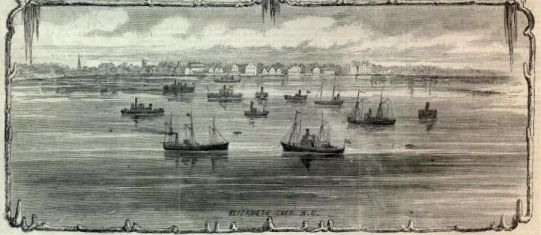Elizabeth City, Battle of
 The Battle of Elizabeth City, also known as the Battle of Cobb's Point, was a Civil War engagement between Union and Confederate gunboats on the Pasquotank River in February 1862. Flag Officer William F. Lynch commanded a flotilla of small Confederate gunboats, formerly comprising the North Carolina Navy, which was charged with defending the sounds of eastern North Carolina. The vessels-small river steamers and tugs, each armed with one or two heavy cannons-were derisively dubbed the "Mosquito Fleet."
The Battle of Elizabeth City, also known as the Battle of Cobb's Point, was a Civil War engagement between Union and Confederate gunboats on the Pasquotank River in February 1862. Flag Officer William F. Lynch commanded a flotilla of small Confederate gunboats, formerly comprising the North Carolina Navy, which was charged with defending the sounds of eastern North Carolina. The vessels-small river steamers and tugs, each armed with one or two heavy cannons-were derisively dubbed the "Mosquito Fleet."
On 7 Feb. 1862 Lynch's fleet participated in a day-long artillery engagement with Union gunboats that were attacking Roanoke Island's defenses. After his largest ship was sunk, another disabled by mechanical problems, and most of his ammunition expended, Lynch took his fleet to Elizabeth City that night, and the Union captured the island the next day. Lynch remained to defend the city and the entrance to the important Dismal Swamp Canal leading to Norfolk, Va.
Meanwhile, on the afternoon of 9 February, Cdr. Stephen C. Rowan led a flotilla of 14 Union navy gunboats, fresh from their victory at Roanoke Island, across Albemarle Sound to seek and destroy the Confederate flotilla. Lynch prepared his ships for battle less than two miles below Elizabeth City, where on the west bank of the river at Cobb's Point, a small earthen fort mounting four 32-pounders had been built. With the fort as his chief reliance for defense, Lynch deployed five vessels (Seabird, Ellis, Fanny, Appomattox, and Beaufort) across the river. In addition, a schooner named Black Warrior, armed with two 32-pounders, was anchored near the east bank of the river as a floating battery opposite the fort at Cobb's Point.
Rowan's 14 gunboats carried a total of 40 guns, compared to the 11 on Lynch's 6 ships. Lynch went ashore to inspect the fort, only to discover insufficient troops to work the guns. He was forced to bring ashore most of the crew from the gunboat Beaufort to man the fort's guns and send the Beaufort back to Norfolk with a skeleton crew.
Early on the morning of 10 February, Rowan ascended the river with his fleet. But Rowan's vessels, low on ammunition, did not stop to engage the fort. Instead, they steadily approached the Confederate fleet, withholding their fire until within ¾ mile of the Confederates. Rowan advanced rapidly, opening fire for the first time. The Union gunboats easily passed the fort and the schooner Black Warrior, firing into the schooner and forcing the crew to abandon and then set fire to the vessel to prevent its capture. In the river the Union Commodore Perry rammed the Confederate Seabird, capturing its crew of 42 and leaving it sinking in the river. The Confederate Ellis was boarded by Union sailors from the Ceres, and its commander ordered his crew to escape over the side while he personally fought the boarders with his cutlass. The commander was wounded and the Ellis was taken intact by Union sailors. Several of the Ellis's crew were shot in the water.
The Confederate Fanny was disabled by cannon fire and run ashore, where its crew set it afire and escaped. The Confederate Appomattox alone managed to escape upriver in a running fight and attempted to enter the Dismal Swamp Canal to reach Norfolk. Incredibly, as the vessel tried to enter the mouth of the canal, it was found to be two inches too wide to enter; the ship was destroyed by its crew to prevent capture. At Elizabeth City the Confederate gunboat Forrest, on its way for repairs, was also destroyed to prevent capture. Meanwhile Lynch, who had been unable to get back out to his flagship Seabird before the attack began, abandoned the fort at Cobb's Point and retreated with his men overland to Norfolk.
Rowan's vessels continued up the river and took possession of Elizabeth City, having made short work of the Confederate flotilla. Union forces now had complete control of the northeast sounds of North Carolina. The losses in the unequal battle were light: two Union sailors killed and seven wounded; four Confederates killed and at least seven wounded.
References:
John G. Barrett, The Civil War in North Carolina (1963).
Daniel H. Hill, Bethel to Sharpsburg, vol. 1 (1926).
W. H. Parker, Recollections of a Naval Officer, 1841-1865 (1883).
Additional Resources:
Civil War Daily Gazette: http://civilwardailygazette.com/2012/02/10/the-short-battle-of-elizabeth-city-nc/
Image Source:
The Mosquito Fleet, Elizabeth City, NC. Harper's Weekly, March 15, 1862. Available http://www.sonofthesouth.net/leefoundation/civil-war/1862/march/elizabeth-city-north-carolina.htm (accessed May 17, 2012).
1 January 2006 | Branch, Paul, Jr.